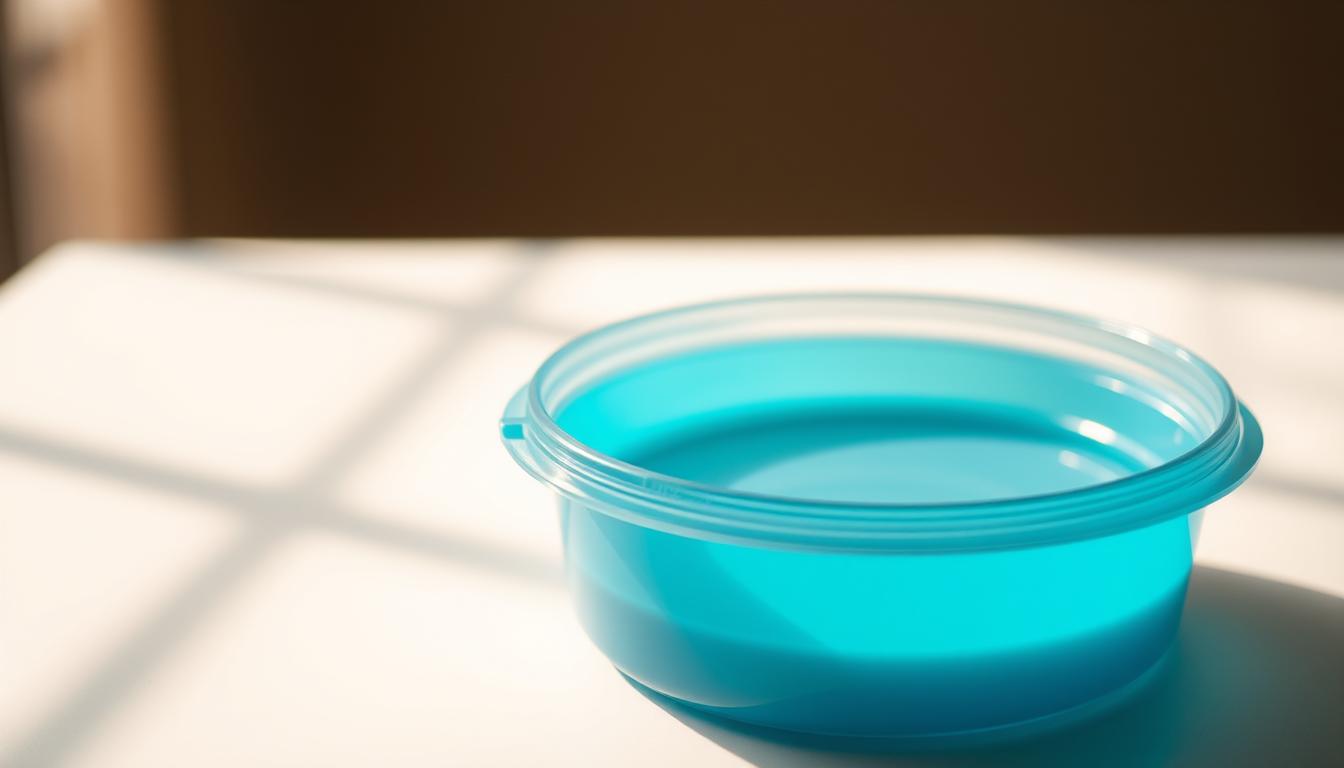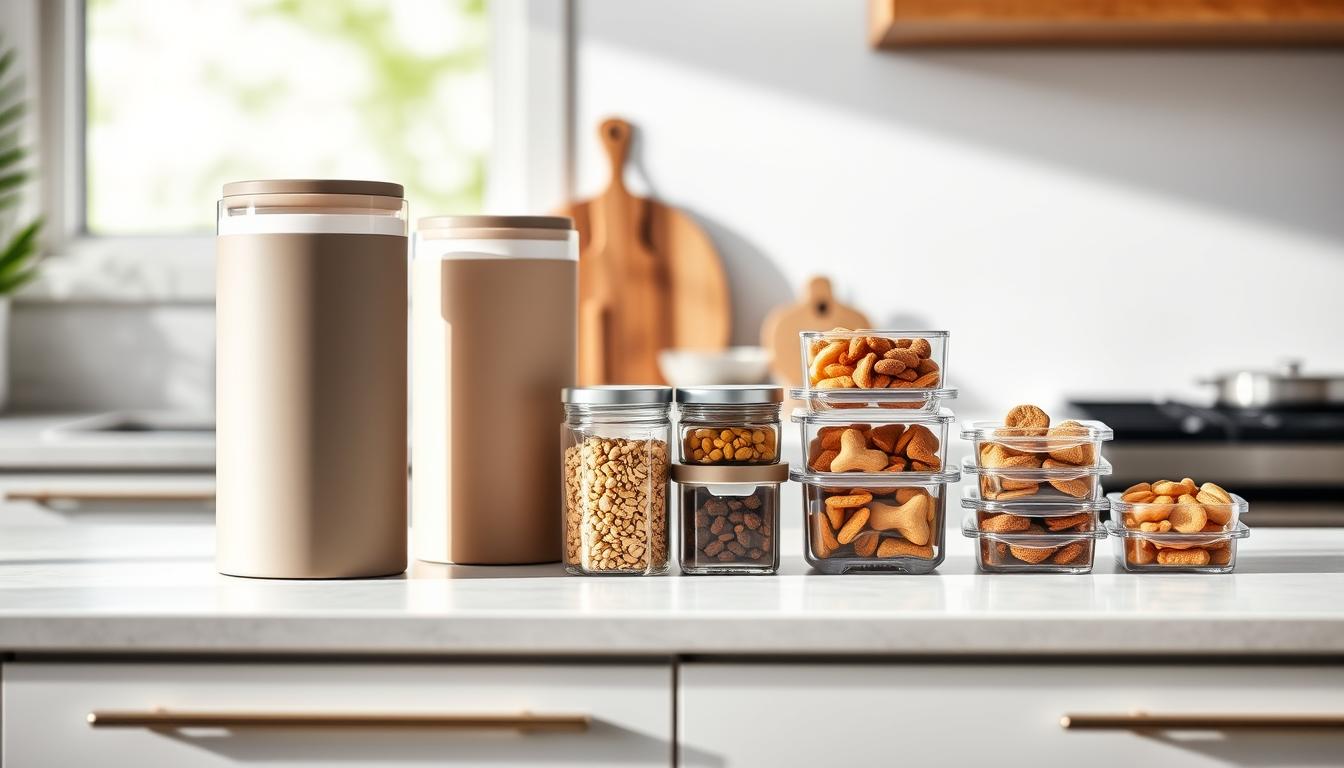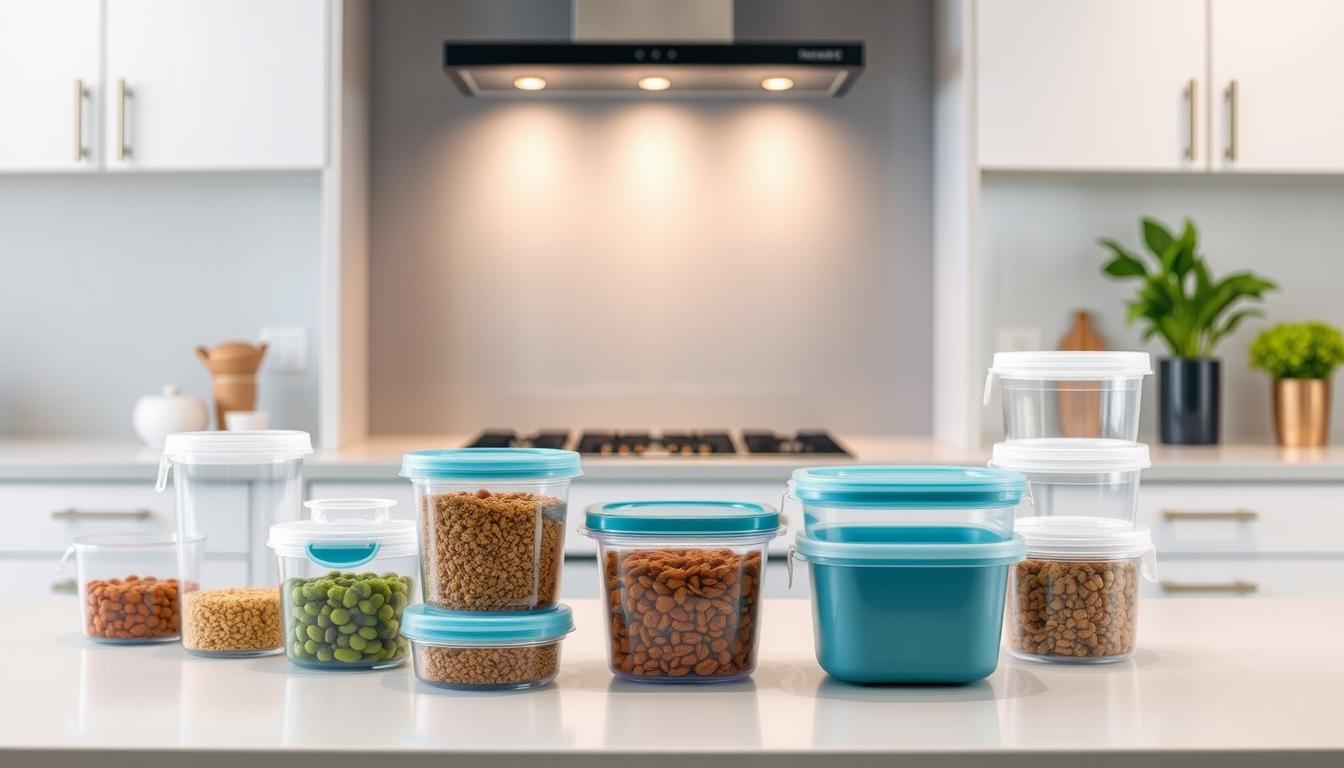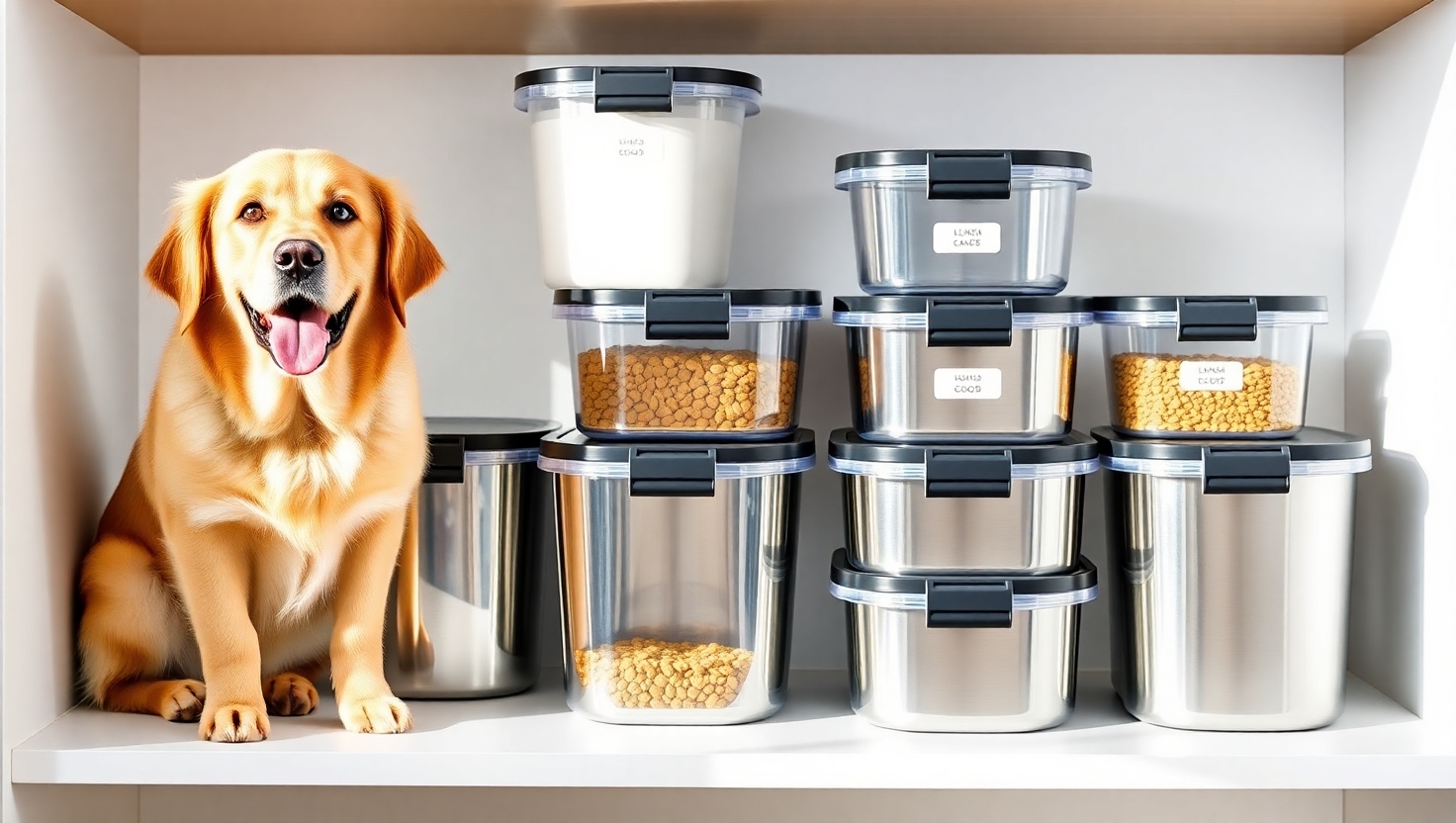Many caring animal lovers don’t realize their furry companion’s meals might face hidden risks after opening the bag. Recent research reveals troubling truths: over 80% of commercial containers for animal meals contain harmful chemicals like BPA. These substances can impact your pet’s health over time, contributing to issues ranging from hormonal imbalances to chronic conditions.

Choosing the right container matters more than you might think. Low-quality materials can leach toxins into kibble or wet food, especially when exposed to heat or moisture. Even short-term exposure (as little as 14 days) has been linked to measurable health changes in animals.
The good news? Safer alternatives now range from basic airtight bins to premium stainless steel systems. We’ll break down the best choices for different needs and budgets, helping you make confident decisions about your companion’s nutrition security.
Key Takeaways
- Common meal containers often contain chemicals that affect animal health
- Chemical exposure risks include hormonal issues and chronic diseases
- Quality containers prevent toxin transfer to meals
- Multiple safe material choices exist across price ranges
- Proper selection supports long-term wellness
Understanding BPA and Its Impact on Pet Food Safety
Common household items might secretly threaten your companion’s meals. Bisphenol A (BPA) hides in everyday plastics and packaging materials – including those designed for animals.

The Chemical Behind the Concern
First developed in 1957, BPA forms the backbone of polycarbonate plastics. Manufacturers use it in epoxy resins that coat metal cans and seal food containers. This chemical easily transfers to meals through:
- Canned food linings
- Plastic storage bins
- Reusable water bowls
Hidden Dangers in Plain Sight
A 2017 analysis revealed alarming contamination levels:
| Product Type | BPA Presence | Health Risk Level |
|---|---|---|
| Dog food cans | 81% | High |
| Cat food cans | 95% | Critical |
| Plastic toys | 68% | Moderate |
Repeated exposure affects animals differently than humans. Their smaller bodies process toxins less efficiently. Within weeks, low doses can disrupt hormone function and metabolic processes.
While the FDA permits BPA in food contact materials, recent studies question its long-term safety. Veterinary researcher Dr. Emily Carter notes: “What’s legally acceptable today might become tomorrow’s health crisis.”
The Importance of Smart Food Storage in Pet Nutrition
Your companion’s meals deserve more attention than you might think. Proper food storage isn’t just about convenience – it’s a frontline defense against nutrient loss and health risks. The FDA advises keeping kibble in its original bag inside containers to preserve expiration dates and batch codes. This simple step helps track recalls and ensures freshness.

Exposure to air and moisture causes vitamins to break down faster. Airtight seals block oxidation that robs meals of essential nutrients. Without proper storage, fats become rancid, and proteins lose their bioavailability. This impacts both safety and taste – no animal enjoys stale kibble!
Common mistakes create three major risks:
| Risk | Result | Solution |
|---|---|---|
| Open bags | Pest contamination | Sealed containers |
| Humidity | Mold growth | Moisture packs |
| Light exposure | Vitamin loss | Opaque materials |
Smart practices protect against bacteria and keep meals appealing. Veterinarian Dr. Lisa Nguyen notes: “Animals often refuse food that’s lost its aroma – proper containers maintain palatability.” Investing in quality solutions means fewer vet visits and happier mealtimes.
Remember: how you store meals matters as much as what you serve. The right approach preserves nutritional value while giving peace of mind. Your furry friend’s bowl benefits directly from these simple yet crucial habits.
BPA free dog food storage options
Selecting the right container for your pet’s meals involves more than just picking a size. Three material types dominate safe preservation: glass, stainless steel, and specially certified plastics. Each offers unique benefits for different lifestyles and budgets.

Iris USA leads in plastic solutions with polypropylene containers that block chemical transfer. Their airtight lids keep meals fresh while meeting strict safety standards. For outdoor use or bulk storage, Vittles Vault’s stackable units combine portability with BPS-free construction.
| Material | Best For | Key Features |
|---|---|---|
| Stainless Steel | Active households | Dent-resistant, easy cleaning |
| Glass | Small spaces | Non-porous, visible contents |
| Certified Plastic | Large quantities | Lightweight, stackable |
Simplehuman’s hybrid design merges stainless steel durability with silicone-sealed liners. This approach prevents rust while maintaining freshness. “Polypropylene codes (#5 PP) indicate safer plastic choices,” notes container safety expert Mark Thompson.
Consider your pet’s eating habits and kitchen space when choosing. Small breeds do well with compact glass containers, while multi-pet homes benefit from Vittles Vault’s 60-pound capacity. Always check for recycling symbols and material certifications before purchasing.
Comparing Material Options: Plastic, Stainless Steel, and Glass
The materials you choose for keeping meals fresh play a critical role in your companion’s health. Each option brings unique strengths and trade-offs worth considering.

Plastic Containers: Benefits and Drawbacks
Lightweight designs make plastic containers easy to move and stack. High-quality versions resist dents and won’t rust, perfect for busy households. They come in shapes to fit tight spaces or bulk quantities.
Cheap plastics may warp over time, while premium polypropylene models maintain shape. “Always check recycling codes – #5 PP indicates safer construction,” advises home organization expert Rachel Kim.
Stainless Steel and Glass: Premium Alternatives
Metal containers made from stainless steel handle rough use without scratching. Their non-porous surfaces block odors better than plastic. Glass offers complete chemical safety but requires careful handling due to weight.
| Material | Best Feature | Consideration | Cost Range |
|---|---|---|---|
| Plastic | Portability | Quality varies | $15-$50 |
| Stainless Steel | Durability | Needs drying | $30-$120 |
| Glass | Safety | Break risk | $25-$80 |
Metal options need thorough drying to prevent rust spots. Glass works well for countertop displays but struggles in garages or RVs. Your storage location and lifestyle ultimately determine the best fit.
Consider how often you refill containers and whether kids help with feeding. The right choice balances safety, convenience, and your peace of mind.
Evaluating Durability and Longevity of Storage Containers
Choosing between materials becomes easier when considering how they hold up over time. High-quality plastic containers can serve you well for years with proper care, while metal solutions often outlast them despite higher upfront costs.

Long-Term Use vs. Daily Convenience
Stainless steel containers typically survive a decade of daily use. Plastic models last 3-5 years before showing wear. Metal’s dent resistance makes it ideal for active homes, while plastic’s lightweight design suits frequent movers.
Consider these factors when comparing materials:
| Material | Average Lifespan | Cost Over 5 Years | Best For |
|---|---|---|---|
| Plastic | 3-5 years | $45 | Budget-conscious owners |
| Stainless Steel | 10+ years | $85 | Multi-pet households |
| Glass | 7-8 years | $65 | Countertop storage |
Rotate plastic containers away from direct sunlight to prevent brittleness. Dry metal thoroughly after washing to avoid water spots. “Inspect seals monthly – cracked gaskets let air spoil food faster,” advises home organization specialist Laura Bennett.
Replacement signs include cloudy plastic or rust streaks. Many premium containers offer 5-year warranties covering defects. Match your choice to how often you access meals – bulk storage needs sturdier materials than daily-use countertop containers.
Smart selection balances immediate needs with future savings. The right storage container becomes a lasting partner in keeping meals fresh and safe.
Airtight Seals and Freshness Preservation Features
The secret to lasting freshness lies in how well a container locks out air. Oxygen exposure breaks down fats and vitamins in meals, turning nutritious kibble into stale crumbs. A 2022 study showed opened bags lose 40% of vitamin E within two weeks when stored improperly.

Maintaining Nutritional Integrity
Modern containers use three main sealing systems:
| Seal Type | Effectiveness | Best For |
|---|---|---|
| Silicone gaskets | Blocks 99% air | Humid climates |
| Snap-lock lids | Easy daily access | Small portions |
| Twist-top mechanisms | Childproof security | Multi-pet homes |
Vittles Vault’s Gamma Seal technology uses threaded lids that create vacuum-like closure. These containers airtight designs prevent mold by keeping humidity below 15% – critical for grain-free formulas. Plastic models like Iris USA’s Weathertight series feature rubberized edges that compress when locked.
Check seals monthly by closing empty containers underwater. Bubbles reveal weak spots. Dr. Sarah Wilkins, veterinary nutritionist, notes: “Proper sealing preserves aroma compounds that make meals appealing to sensitive noses.”
Frequent opening affects preservation. Larger containers need stronger seals than daily-use bins. Match your pet’s eating habits to the right closure system – bulk storage thrives with screw-top lids, while portion-control containers benefit from quick-access snaps.
Ease of Cleaning and Maintenance
Keeping your companion’s meals fresh starts with proper container care. Different materials demand unique cleaning approaches to maintain safety and functionality. Let’s explore how to keep various options spotless and odor-free.
Stainless steel resists lingering smells naturally due to its non-porous surface. A quick wash with soap and water removes most residue. Plastic requires more attention – its textured surfaces can trap grease particles that lead to odors over time.
| Material | Cleaning Method | Drying Time | Odor Control |
|---|---|---|---|
| Stainless Steel | Dishwasher-safe | 5 minutes | Excellent |
| Plastic | Hand wash recommended | 2 hours | Good (with baking soda) |
| Glass | Both methods | 30 minutes | Superior |
Busy owners love dishwasher-friendly designs. Many metal and glass containers handle high heat cycles well. For plastic, check manufacturer guidelines – some warping may occur at extreme temperatures.
Follow these steps weekly for optimal hygiene:
- Empty all remaining food particles
- Scrub with mild detergent
- Rinse thoroughly
- Dry completely before refilling
Metal containers need immediate drying to prevent water spots. Use microfiber cloths for streak-free results. Plastic benefits from monthly deep cleans – mix 1 part vinegar with 2 parts water to neutralize stubborn smells.
Look for wide-mouth designs and removable seals that simplify scrubbing. Consumer Reports found containers with smooth interiors reduce bacterial growth by 62% compared to textured models. As organization expert Tina Reynolds advises: “Prevention beats deep cleaning – wipe spills immediately for easier maintenance.”
Portability and Versatility in Dog Food Storage
Modern pet owners need solutions that move as easily as their lifestyles demand. Lightweight designs make mealtime management simpler whether you’re stocking a camper or organizing a pantry.
Designs That Fit Any Home
Plastic models shine for their grab-and-go convenience. Brands like Iris USA offer stackable containers that tuck under counters or slide into tight spaces. Their modular systems let you customize storage layouts for apartments or RVs.
Compare popular options:
| Feature | Plastic | Metal |
|---|---|---|
| Weight (5-gallon) | 2.1 lbs | 8.4 lbs |
| Stackable | Yes | No |
| Handle Options | 62% have grips | 24% include handles |
Multiple shapes sizes help portion meals while keeping bulk purchases fresh. Slim vertical bins save floor space, while wide-mouth designs simplify scooping. Vittles Vault’s 7-pound units work well for weekend trips or patio feeding stations.
Look for these mobility boosters:
- Reinforced handles that won’t snap
- Wheeled bases for 25+ pound capacities
- Interlocking lids during transport
Heavy metal containers suit permanent kitchen corners but struggle in multi-level homes. “Choose lighter materials if stairs factor into your routine,” advises organizer Jenna Cole. Easy-open latches prove handy when balancing leashes or baby monitors during feeding time.
Smart storage adapts to your life – not the other way around. Whether you need grab-and-go convenience or space-maximizing stacks, today’s options deliver practical solutions for every household.
Health and Safety: Avoiding Harmful Chemicals
What you can’t see in your pet’s meals might surprise you. Everyday products often contain hidden risks that affect nutritional quality and safety. Smart choices require understanding labels and material science.
Decoding Safety Certifications
Look for these trusted marks when selecting containers:
| Certification | Scope | Trust Level |
|---|---|---|
| FDA 21 CFR | Food contact materials | Mandatory |
| NSF/ANSI 51 | Plastics safety | Premium |
| LFGB Germany | Chemical migration | Global standard |
Manufacturers use these codes to indicate plastic safety:
- #1 PET – Single-use only
- #2 HDPE – High-density safety
- #5 PP – Microwave-safe choice
Material Matters
Stainless steel outperforms other materials in three key ways:
- Non-porous surface blocks bacteria
- No chemical coatings required
- Withstands repeated cleaning
“Many ‘BPA-free’ plastics contain BPF or BPS substitutes with similar risks,” warns materials scientist Dr. Karen Lee. Always check for full ingredient disclosures rather than marketing claims.
Follow these tips for lasting safety:
- Avoid containers with painted interiors
- Discard scratched or cloudy plastic
- Dry thoroughly after washing
Your choices directly impact mealtime security. With proper knowledge, you can create a protective barrier between harmful substances and your companion’s nutrition.
Environmental Impact of Material Choices
Every purchase decision leaves a footprint beyond your kitchen. Containers made from conventional plastic contribute to 18% of landfill waste annually. Production emissions for petroleum-based materials release 3x more carbon than metal alternatives.
Stainless steel lasts 15+ years, reducing replacement frequency. Glass offers full recyclability but requires more energy to transport. Polypropylene plastic (code #5) balances durability with lower shipping weights.
Consider these eco-factors when making your choice:
- Recycling compatibility in local programs
- Energy used during manufacturing
- End-of-life disposal methods
Proper disposal matters – 67% of pet food packaging ends up in oceans. Opt for containers with clear recycling symbols. “Multi-use solutions always beat single-cycle products,” notes sustainability expert Dr. Mia Chen.
Your choice today shapes tomorrow’s ecosystems. Durable materials protect both meals and the planet, creating safer homes for all creatures.
FAQ
Why should I avoid plastics for storing kibble?
Some plastics contain chemicals that can leach into meals over time, especially when exposed to heat or moisture. Opt for containers made of stainless steel or glass to minimize potential health risks.
How do airtight seals help keep meals fresh?
Airtight locks prevent oxygen and humidity from entering, slowing spoilage and preserving nutrients. This ensures your furry friend’s meals stay crisp and flavorful for weeks.
Are stainless steel containers worth the investment?
Yes! They’re durable, rust-resistant, and easy to clean. Unlike some plastics, they won’t absorb odors or degrade over time, making them a long-term solution for pet care.
What certifications should I look for in safe products?
Seek labels like FDA-approved or NSF-certified, which confirm materials meet strict safety standards. These ensure no harmful substances interact with your companion’s nutrition.
Can I reuse old packaging for dry kibble?
It’s not ideal. Original bags aren’t designed for long-term use and may lack proper seals. Dedicated containers with tight-fitting lids offer better protection against pests and moisture.
Do glass jars work for large breeds?
While glass is non-toxic and easy to sanitize, it’s heavy and breakable. For bigger portions, consider lightweight, stackable stainless steel bins that combine safety with practicality.
How often should I wash storage units?
Clean them every 2-3 weeks or after refilling to prevent residue buildup. Use mild soap and warm water—avoid harsh chemicals that could leave unsafe traces behind.
Also Read:


